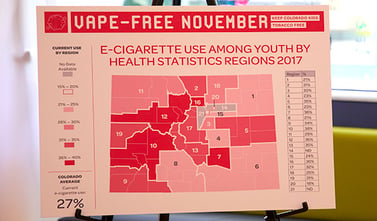Gov. John Hickenlooper joined leading health organizations, including the University of Colorado Cancer Center and Children’s Hospital Colorado, in calling for a reduced tobacco use and vaping among youth — an urgent issue given a recent report that Colorado leads the nation in teen vaping.
In a press conference at Children’s Hospital Colorado on Nov. 2, Hickenlooper signed both a proclamation recognizing “Vape-Free November” in Colorado and an executive order that takes steps to curb vaping. Also speaking were Amy Sass, MD, associate professor of pediatrics-adolescent medicine in the CU School of Medicine and a Children’s Hospital Colorado physician; and Tista Ghosh, MD, interim chief medical officer for the Colorado Department of Public Health and Environment (CDPHE).
This graphic shows the rate of e-cigarette use among youth in Colorado counties in 2017.
The health leaders called the youth use of vapor products, known as vape or e-cigarettes, an “epidemic of nicotine addiction,” leaving teens at risk for long-lasting effects of exposing their developing brains to nicotine. The risks include nicotine addiction, mood disorders and decreased impulse control.
Sass said she sees firsthand evidence of vaping among her youth patients, and notes that even children in elementary school are reporting experimenting with vaping. She said misconceptions abound that vaping products are not as harmful as cigarette smoking.
One in four teens vape
“The aerosols in many of these electronic nicotine devices are equally harmful, both to the user and bystanders who are exposed to the vapors,” she said. “These are pollutants and can contain harmful chemicals including carcinogens and heavy metals.”
Sass said it’s important for health care providers, as well as parents, to talk with youth and their families about the health risks of vaping. Colorado has made great strides in curbing cigarette use in Colorado, she said, and “it’s going to take a similar multifaceted approach to address the issue of vaping.”
Ghosh said more than one in four of Colorado high school students use vaping products and almost half have experimented with them. “When our kids experiment with vaping, they think they are just using flavored water,” she said. “What they don’t realize is that almost all vapor products sold in convenience stores contain nicotine.”
Risky behavior
Studies indicate that vaping might be an indicator for other high-risk behaviors, said Ghosh, who is an adjunct assistant professor in epidemiology for the Colorado School of Public Health. “Teens in Colorado who vape are more likely to binge drink, use marijuana, use prescription pain not prescribed to them, and engage in other risky behavior,” she said.
Hickenlooper said the nation-leading rate of teen vaping is not a distinction Colorado wants to have. “I think it would be foolhardy and irresponsible if we didn’t address this … Like so many challenges we’re trying to address with a holistic approach, we need to educated family members, friends and make sure policy makers and the whole community understands what this means.”
TOBACCO PREVENTION BLUEPRINT
The executive order also makes suggestions for the Legislature to consider, including:
- Raise the minimum sales age for tobacco and e-cigarette products to 21. Coloradans must be 21 to buy alcohol or marijuana, but only 18 to purchase tobacco and vaping products.
- Prohibit the sale of flavored tobacco and vaping products in Colorado.
- Require all retailers of tobacco products, e-cigarettes and vaping products to be licensed.
- Extend the excise tax on tobacco products to e-cigarettes, vaping devices and liquids.
The executive order also calls for:
- Directs the Department of Revenue to double its compliance checks of tobacco and e-cigarette retailers to ensure they are not selling to underage persons.
- Extends the current prohibition on smoking in state buildings to e-cigarettes and vaping. It also extends prohibitions on smoking and vaping to the grounds of state buildings, not just the buildings themselves.
- Directs CDPHE to issue a health advisory on e-cigarettes and vaping.
- Directs CDPHE to investigate the association between vaping and other risky behavior and identify programs to prevent those behaviors.
Hickenlooper said, “We want to say with one voice: Put down the pods; trash the pens; and live a little.”


.png)

